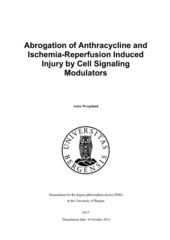| dc.contributor.author | Wergeland, Anita | en_US |
| dc.date.accessioned | 2014-02-04T09:13:04Z | |
| dc.date.available | 2014-02-04T09:13:04Z | |
| dc.date.issued | 2013-10-18 | eng |
| dc.identifier.isbn | 978-82-308-2370-5 | en_US |
| dc.identifier.uri | https://hdl.handle.net/1956/7761 | |
| dc.description.abstract | Chemotherapy has a long history in cancer treatment, and the anthracycline used in Paper I and II are among the most effective anti-cancer drugs developed. Unfortunately, the use of anthracyclines is dose-restricted due to the risk of cumulative toxicity in healthy tissue, most notably in the heart. Targeted therapy using all-trans retinoic acid (ATRA) is used to differentiate, and hence, eliminate acute promyelocytic leukemia (APL) cells, and is combined with low dose anthracyclines to remove live or ATRA resistant cells. Recently, cAMP was recommended as adjuvant to standard APL therapy since it enhances ATRA induced differentiation of APL cells. In Paper I we demonstrate that cAMP in fact abrogate the anti-cancer effect of the anthracycline Daunorubicine (DNR) in blasts from APL patients and also in ATRA-sensitive and insensitive APL cell lines. The protection was dependent on the cytoplasmic PKA-type I rather than perinuclear PKA type-II, and was associated with (inactivating) phosphorylation of pro-apoptotic Bad and (activating) phosphorylation of the acute myeloid leukemia (AML) oncogene cAMPresponsive element binding protein (CREB). Mice with orthotopic NB4 cell leukemia showed a more rapid disease progression when given cAMP-increasing agents (prostaglandin E2 analog and aminophylline), both with and without DNR chemotherapy. Together this suggests that the beneficial pro-differentiating and nonbeneficial pro-survival APL cell effects of cAMP should be weighed against each other. Although the mechanism behind anthracycline mediated cardiotoxicity is highly contested, intramyocardial production of reactive oxygen species (ROS) is generally accepted as a strong candidate, and has increased the focus on antioxidants in cardioprotective strategies. In Paper II, we demonstrate that Red Palm Oil (RPO) supplemented diet during chemotherapy attenuate cardiotoxic side-effects of daunorubicin, by improving aortic output and coronary flow in the isolated working rat heart model. Improved hemodynamic was accompanied by stabilization of important antioxidant systems (SOD1 and NOS1) and reduction of stress-induced MAPK activation. While cancer is a consequence of restricted cell death, the opposite scenario, with increased cell death is an important component of ischemia-reperfusion induced injury. Since prolonged ischemia may lead to cardiac cell death, rapid and adequate reperfusion is a necessity to salvage the compromised cardiac tissue. Paradoxically, reperfusion per se also induces cell death (lethal reperfusion injury) a process involving opening of the mitochondrial permeability transition pore (mPTP). Different ways to limit or delay cardiomyocyte cell death have emerged in the laboratory setting, and are evaluated as clinical candidates to further improve the outcome of patients with acute myocardial infarction (AMI). In paper III and IV we utilize the Langendorff perfusion setup for the ex vivo rat heart, to evaluate different therapeutic strategies to reduce ischemia-reperfusion induced injury. In Paper III we show that corticotropin releasing factor (CRF) significantly reduce infarct size when applied to the heart prior to a lethal ischemic insult, and was cytoprotective in neonatal mouse cardiomyocytes when added prior to a lethal simulated ischemic event (hypoxia). CRF was however not protective when administered at the point of ischemic reperfusion or hypoxic reoxygenation. The cardioprotective effects of CRF was mediated via activation of PKA and PKC dependent signaling pathways downstream of CRF receptor type 2 (CRFR2). In Paper IV we evaluated the possible additive effects of combining known cardioprotective treatments. We found that combining insulin reperfusion therapy with direct Glycogen synthase kinase 3 β (GSKβ) inhibition at reperfusion did not confer any additive effect, but showed similar cardioprotection as seen when the treatments were administered separately. Surprisingly, we found that combining either of the two pharmacologic interventions with ischemic postconditioning (IPost) abrogated all cardioprotective effect. This loss of cardioprotection was accompanied with blunted Akt phosphorylation. To our knowledge, we are the first to demonstrate the loss of protection when combining two otherwise cardioprotective regimes. | en_US |
| dc.language.iso | eng | eng |
| dc.publisher | The University of Bergen | eng |
| dc.relation.haspart | Paper I: Gausdal G, Wergeland A, Skavland J, Nguyen E, Pendino F, Rouhee N, McCormack E, Herfindal L, Kleppe R, Havemann U, Schwede F, Bruserud O, Gjertsen BT, Lanotte M, Ségal- Bendirdjian E, Døskeland SO. Cyclic AMP can promote APL progression and protect myeloid leukemia cells against anthracyclineinduced apoptosis. Cell Death Dis. 2013 Feb 28;4:e516. The article is available at: <a href="http://hdl.handle.net/1956/7760" target="blank"> http://hdl.handle.net/1956/7760</a> | en_US |
| dc.relation.haspart | Paper II: Wergeland A, Bester DJ, Sishi BJN, Engelbrecht AM, Jonassen AK, Van Rooyen J. Dietary red palm oil protects the heart against the cytotoxic effects of anthracycline. Cell Biochem Funct. 2011 Jul 29(5):356-64. The article is not available in BORA due to publisher restrictions. The published version is available at: <a href="http://dx.doi.org/10.1002/cbf.1756" target="blank">http://dx.doi.org/10.1002/cbf.1756</a> | en_US |
| dc.relation.haspart | Paper III: Jonassen AK, Wergeland A, Helgeland E, Mjøs OD, Brar BK. Activation of corticotropin releasing factor receptor type 2 in the heart by corticotropin releasing factor offers cytoprotection against ischemic injury via PKA and PKC dependent signaling. Regul Pept. 2012 Feb 10; 174(1-3):90-7. The article is not available in BORA due to publisher restrictions. The published version is available at: <a href="http://dx.doi.org/10.1016/j.regpep.2011.12.005" target="blank">http://dx.doi.org/10.1016/j.regpep.2011.12.005</a> | en_US |
| dc.relation.haspart | Paper IV: Helgeland E, Wergeland A, Breivik L, Askeland M, Jonassen AK. Abrogated Cardioprotection and Blunted Akt Phosphorylation when Combining Ischemic Postconditioning with Pharmacological Reperfusion Therapy. The article is not available in BORA. | en_US |
| dc.title | Abrogation of Anthracycline and Ischemia-Reperfusion Induced Injury by Cell Signaling Modulators | en_US |
| dc.type | Doctoral thesis | |
| dc.rights.holder | Copyright the author. All rights reserved | |
